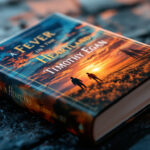Harry Potter and the Goblet of Fire – A Comprehensive Book Review
Released on July 8, 2000, Harry Potter and the Goblet of Fire is the fourth installment in J.K. Rowling’s acclaimed fantasy series. This book bridges the lighthearted adventures of earlier entries with the darker, more intense themes that will define the series moving forward. Packed with intrigue, action, and emotional depth, this novel introduces readers to the high-stakes Triwizard Tournament and explores the complexities of Harry’s world as it grows increasingly perilous. Its layered storytelling, detailed character arcs, and moral challenges make it a standout entry, cementing its importance in the series.
Plot Overview
Harry Potter and the Goblet of Fire takes readers into Harry’s fourth year at Hogwarts, where the story begins with excitement and camaraderie but quickly spirals into peril and darkness. The book balances magical exploration with increasing tension that hints at the sinister forces brewing in the background. From the adrenaline of the Quidditch World Cup to the high-stakes Triwizard Tournament, Harry finds himself grappling with challenges that far surpass his age—and his victories come at unspeakable costs. Below, we’ll explore two significant aspects of the book’s plot: the Triwizard Tournament and Voldemort’s chilling return.
The Triwizard Tournament
The Triwizard Tournament is at the heart of the novel, serving both as a thrilling magical competition and a vehicle for Harry’s personal growth. This ancient, prestigious event brings together three wizarding schools: Hogwarts, Beauxbatons, and Durmstrang. Each school selects a champion to compete in tasks that test bravery, intelligence, and magical ability. The twist? Harry—underage and initially ineligible—is mysteriously chosen as the fourth participant, a decision that casts a shadow over the tournament from the very beginning.
The tournament unfolds in three daunting tasks. Each is symbolic in its own way, forcing Harry to face physical, emotional, and moral trials. The underwater task, for instance, challenges his sense of loyalty when he must prioritize rescuing Ron from the depths of the Black Lake. These moments of crisis reveal not just Harry’s courage but his deep sense of responsibility and humanity.
The Triwizard Tournament is more than a spectacle—it’s a breeding ground for conflict and uncertainty. Tensions run high as the champions navigate not only the dangerous tasks but also interpersonal rivalries and alliances. The book also highlights the larger wizarding world’s politics and prejudices, as seen in the interactions between schools, particularly Hogwarts and Durmstrang. By combining action with intense character development, the tournament propels Harry’s journey forward, setting the stage for the dark revelations that follow.
To read more about the tournament’s structure and importance, check out this comprehensive summary.
Voldemort’s Return
The climax of Goblet of Fire builds to one of the most pivotal moments in the Harry Potter series: Voldemort’s resurrection. During the book’s concluding chapters, Harry is transported to a graveyard via a Portkey, where he finds himself face-to-face with Lord Voldemort. Peter Pettigrew—Wormtail—uses Harry’s blood in a dark ritual that restores Voldemort to a fully corporeal and terrifying form.
This event is not just shocking; it casts a long shadow over the entire series’ narrative. Voldemort’s return signifies the end of innocence for Harry and his friends, marking a definitive shift from adventure to impending war. The scene in the graveyard is harrowing in its portrayal of evil, from the callous murder of Cedric Diggory to the macabre ritual itself. It doesn’t simply reintroduce Voldemort as an antagonist; it underscores the thematic weight of power, sacrifice, and the inevitability of loss.
This moment also establishes the profound connection between Harry and Voldemort. From the magical duel that echoes the complexities of their intertwined destinies to Harry’s narrow escape back to Hogwarts, the scene leaves readers reeling and braced for the battles to come. It is here that the childlike wonder of Rowling’s earlier books gives way to a darker, more complex reality.
For an in-depth exploration of this pivotal turning point, visit this Harry Potter compendium entry.
Final Thoughts
The Triwizard Tournament and Voldemort’s shocking return perfectly encapsulate the dual nature of Goblet of Fire: magical wonder intertwined with grim consequences. These defining moments raise the stakes for the entire series and offer readers a gripping, unforgettable story.
Character Development
J.K. Rowling’s Harry Potter and the Goblet of Fire masterfully develops its rich cast of characters, showcasing growth, resilience, and the complex interplay of personalities. This installment stands out for its layered portrayals, making both familiar and new characters central to the story’s emotional depth and narrative progression.
Harry’s Growth as a Protagonist
In Goblet of Fire, Harry transitions from the somewhat wide-eyed boy of earlier books to a more mature and introspective character. This evolution is most evident in how he navigates the intense emotional and physical challenges he faces throughout the story.
One of the most defining aspects of Harry’s growth in this book is his ability to confront trauma head-on. From witnessing Cedric Diggory’s death to narrowly surviving Voldemort’s rebirth, Harry is thrust into harrowing situations that would be overwhelming for anyone, let alone a fourteen-year-old. But instead of succumbing to despair, Harry demonstrates remarkable bravery and emotional strength. He begins to reckon with the gravity of his role as Voldemort’s adversary while grappling with the shock of what he has endured.
Harry also learns the value of emotional connection. His relationships with friends like Ron and Hermione deepen as they support him through the mysterious selection as a fourth Triwizard Champion and the dangerous tournament tasks. Still, isolation becomes a recurring theme for Harry—whether it’s facing skepticism about his selection or recounting the horrors of Voldemort’s return to doubting adults. These moments highlight his resilience but also reinforce his increasing detachment from the simpler joys of childhood.
Harry’s transformation in this book is a precursor to the darker themes that dominate later installments. His courage is unmistakable, but so too is his growing awareness of the peril and responsibility tied to his place in the wizarding world. To explore more about Harry’s profound character development, check out this insightful analysis.
New Characters and Their Impact
One of the unique aspects of Goblet of Fire is the introduction of several key characters whose influence extends beyond this book. Cedric Diggory, Fleur Delacour, and Viktor Krum are more than just fellow Triwizard competitors; their presence enriches the story, offering different perspectives and challenging Harry’s worldview.
- Cedric Diggory: As Hogwarts’ “official” champion, Cedric represents what Harry might aspire to be in terms of skill and character. Charming, fair-minded, and just as brave, Cedric is a stark contrast to other characters who disdain Harry’s participation in the tournament. His tragic death in the final chapters is a heartbreaking moment that solidifies the gravity of Voldemort’s return and serves as Harry’s first exposure to mortal loss. Cedric’s fate leaves an indelible mark, remaining a symbol of innocence lost in the fight against evil.
- Fleur Delacour: Hailing from Beauxbatons Academy, Fleur initially comes across as aloof and overly confident. However, throughout the tournament, her humanity and vulnerability emerge, challenging stereotypes and adding a cultural dimension to the wizarding world. While Fleur doesn’t play a central role in this book, her presence foreshadows significant interactions in later installments that paint her in a new light.
- Viktor Krum: As Durmstrang’s champion and a world-renowned Quidditch star, Viktor Krum might seem larger than life. Yet, Rowling portrays him as introspective and somewhat reserved, providing unexpected depth. Krum’s relationship with Hermione also adds drama to the trio’s dynamic, making him an essential piece of both the competition and Harry’s adolescent experience.
These characters’ inclusion captures the global scale of the wizarding world, offering windows into other magical traditions and practices. They also amplify the deeper themes of equality, cooperation, and loss, making their presence not just interesting but indispensable to the story’s structure. For more insights into how these characters complement the broader narrative, visit this character breakdown.
Themes and Symbolism
Harry Potter and the Goblet of Fire delves deep into themes that transcend its magical essence, solidifying its place as more than just a fantasy novel. The story intricately weaves messages of bravery, morality, and unity, all of which resonate universally. Here, we’ll explore two overarching themes: courage in the face of adversity and the dangers of prejudice and division.
Courage in the Face of Adversity
Throughout the Triwizard Tournament, courage emerges as one of the series’ most defining traits, especially when embodied by Harry. His journey in this book is a testament to pushing through fear, doubt, and overwhelming odds. Despite being thrust into the tournament against his will, Harry chooses to face every challenge head-on rather than shrink back.
In the first task, Harry confronts a fire-breathing dragon to retrieve a golden egg. While the task requires immense skill, what truly shines is Harry’s ability to stay composed under immense pressure. His common sense and bravery allow him to outwit the dragon using his broomstick. Later, in the underwater challenge, Harry’s choice to save others’ lives, even when not required, demonstrates courage paired with compassion. Could there be a better example of bravery rooted in humanity?
The final task, however, is where bravery reaches its pinnacle. Faced with a terrifying graveyard encounter, Harry not only witnesses Cedric Diggory’s tragic death but also stands against Voldemort’s rebirth. The sheer terror of this moment feels palpable, yet Harry refuses to give in. His ultimate act of defiance is escaping with Cedric’s body, bringing honor to his fallen friend. This moment encapsulates the darkest risks that courage demands and its undeniable necessity.
For additional insights on Harry’s courage, take a look at this thought-provoking piece.
The Danger of Prejudice and Division
Prejudice and division are recurring elements in the Harry Potter series, but they take on a sharper focus in Goblet of Fire. From the house rivalries at Hogwarts to the fractured relationships among wizarding communities, the story highlights the destructive nature of discrimination and intolerance.
The animosity between Hogwarts houses, particularly Gryffindor and Slytherin, is exacerbated when Harry’s name is pulled from the Goblet of Fire. Instead of rallying behind him, many in his own house question his honesty, a reflection of how distrust can breed within communities. Similarly, the Triwizard Tournament itself becomes a battleground for national and institutional biases. The strained interactions between the Hogwarts, Beauxbatons, and Durmstrang delegations underline the difficulties of uniting disparate groups despite shared goals.
This division echoes the larger inequalities in the wizarding world. The Death Eaters embody the most dangerous outcomes of prejudice. Their ideologies—centered on blood purity and supremacy—reveal the havoc caused when differences are not only highlighted but weaponized. The book’s climactic graveyard scene underscores this theme, as Voldemort’s revival is a chilling reminder of what unchecked hatred can escalate into.
Through these narrative threads, Rowling reminds us of the perils of division and the essential need for unity. It’s a call to examine the walls we build within communities and the broader impact of our biases. For a detailed exploration, visit SparkNotes’ breakdown of themes.
By exploring the essence of courage and warning against the dangers of prejudice, Harry Potter and the Goblet of Fire offers readers valuable lessons—both within and beyond its storied universe.
Critical Reception and Impact
When Harry Potter and the Goblet of Fire was released in 2000, it marked a significant moment not only for J.K. Rowling’s bestselling series but also for the way young adult literature was perceived. The fourth book in the series took readers into darker, more mature territory, striking a chord with fans of all ages. Here, we examine the audience’s reactions and the legacy this book has left within the series and beyond.
Audience Reactions and Popularity
From the moment of its release, Harry Potter and the Goblet of Fire received worldwide acclaim. For young readers, the book introduced thrilling elements like the Triwizard Tournament, a magical competition that captured the excitement of adventure and discovery. The expansion of the wizarding world to include students from Beauxbatons and Durmstrang added layers of intrigue and diversity that younger audiences found captivating. Many children of the time eagerly anticipated each new chapter, enthralled by the suspense and challenges that defined Harry’s fourth year at Hogwarts.
Yet, the book was not just for kids. Its darker tone and sophisticated character development appealed to adult readers as well. The gradual shift from whimsical storytelling to more morally complex themes was praised for its ability to engage a mature audience. Topics like loss, betrayal, and the consequences of prejudice resonated with adult readers who saw Rowling’s work as more than just children’s literature. In fact, major reviews, such as this Guardian review, highlighted how Rowling successfully crafted a narrative that bridged age groups, blending magical appeal with real-world relevance.
However, the book was not without criticism. A section of the audience found the pacing uneven, as the first half introduced a myriad of setups before the climactic Triwizard tasks. Additionally, the death of Cedric Diggory was a controversial moment, particularly for parents of younger readers who felt it added an unexpected weight to an otherwise fantastical series. Even so, this departure from lighthearted storytelling only bolstered the book’s reputation for daring to explore new emotional depths. Ultimately, the popularity of Goblet of Fire astonished even its critics, solidifying its place as a fan favorite.
Legacy within the Series and Beyond
Harry Potter and the Goblet of Fire is widely regarded as a pivotal entry in the series. While Rowling’s first three books laid the foundation for a world of magic and wonder, Goblet of Fire was the turning point that deepened the themes and raised the stakes for what was to come. It redefined the series as not just a tale of magic but also a deeply human story exploring complex relationships and moral dilemmas.
One of the book’s defining contributions is its darker narrative shift. The return of Voldemort, coupled with Cedric Diggory’s death, signaled the end of innocence in Harry’s journey. It also introduced readers to the sobering realities of loss and the weight of responsibility, elements that would shape the series moving forward. As noted in this Medium analysis, the book was essential in bridging the lighter, adventure-filled early entries with the grim, war-driven conflicts of later installments.
Moreover, Goblet of Fire pushed boundaries in young adult literature by proving that the genre could tackle difficult topics without losing its core audience. By weaving together adolescent struggles with broader themes of power and responsibility, Rowling established a blueprint that would influence future generations of authors. Comparing its legacy alongside other YA hits like The Hunger Games and Twilight, it’s clear that Goblet of Fire helped lay the groundwork for the current boom in multifaceted, crossover genre fiction.
Even more notably, Goblet of Fire remains a touchstone in discussions about why Harry Potter became a cultural phenomenon. Its layered storytelling, groundbreaking character arcs, and focus on worldbuilding set a new standard for what a fantasy series could achieve. Today, as detailed in this breakdown of key moments, the book is celebrated as not only a masterpiece within the series but also a revolutionary work in the scope of contemporary literature. Whether measured by its immediate reception or its enduring influence, the impact of Goblet of Fire is impossible to ignore.
Conclusion
Harry Potter and the Goblet of Fire stands as a remarkable turning point in J.K. Rowling’s series. Its blend of thrilling plotlines, emotional depth, and darker themes enriches the narrative, marking the transition from childhood wonder to the complexities of a more perilous world. The book’s unforgettable moments—whether in the high-stakes Triwizard Tournament or Voldemort’s fateful return—leave a lasting impact.
This fourth installment challenges readers of all ages to embrace themes of courage, loss, and unity in the face of adversity. Its ability to balance magical escapism with weightier moral questions ensures its enduring appeal.
If you haven’t yet revisited this standout chapter in Harry’s journey—or are diving in for the first time—this is the perfect time to pick it up and explore its magic once more. Let us know your thoughts and favorite moments in the comments below!







